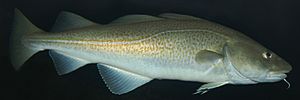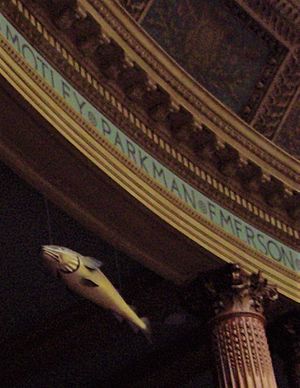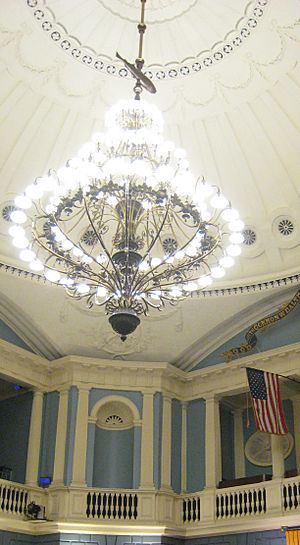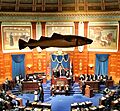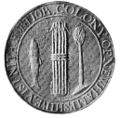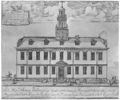Sacred Cod facts for kids
Quick facts for kids The Sacred Cod |
|
|---|---|
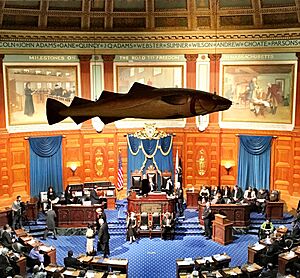
|
|
| Year | 1784 |
| Medium | Woodcarving |
| Dimensions | 4 ft 11 in (150 cm) long |
| Weight | 80 lb (36 kg) |
| Location | Massachusetts State House, Boston |
The Sacred Cod is a large wooden carving of an Atlantic cod fish. It is painted to look like a real fish. This carving hangs in the House of Representatives chamber in Boston's Massachusetts State House. It serves as a reminder of how important cod fishing was to the state of Massachusetts. Cod is even the official "historic and continuing symbol" of Massachusetts.
This famous fish has a long history, with at least three versions over the centuries. The first one was lost in a fire in 1747. The second disappeared during the American Revolution. The third, which is the one you can see today, was put in place in 1784.
The name "Sacred Cod" is a nickname, not its official title. It became popular in 1895. This was after a special committee called it "the sacred emblem." Soon, people used "sacred cod" to talk about real codfish too. This showed how much the fish helped Massachusetts become rich and powerful.
The Sacred Cod has been "kidnapped" a couple of times! In 1933, students from the Harvard Lampoon humor magazine took it. Police even searched the Charles River and an airplane. In 1968, students from the University of Massachusetts Boston also took it briefly.
There's another fish figure in the State House Senate chamber. It's a brass fish above the main chandelier, sometimes called the Holy Mackerel.
Contents
Why the Cod is Important
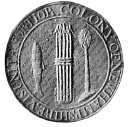
Cod fishing was the very first industry for Europeans in Massachusetts. People say that the colony's first export was a shipment of fish. Because of this, the codfish has been a key symbol in New England for hundreds of years.
You can find the image of a cod on old coins, stamps, and government seals. Even some wealthy families in the 19th century were called the "codfish aristocracy." This showed how much their money came from the fishing industry.
The History of the Sacred Cod

The Sacred Cod has hung in the Massachusetts House of Representatives for about 300 years. However, it wasn't always the same fish. There have been at least two, and possibly three, different versions.
The First Cod
There's an old story that a codfish carving hung in the first House of Assembly. Some believed it was a gift from Judge Samuel Sewall, who died in 1729. But there's no clear proof of this. When the State House burned down in 1747, this first fish was likely destroyed in the fire.
The Second Cod
A second cod appeared sometime after the State House was rebuilt in 1748. We know that in 1773, someone was paid to paint a codfish. However, this second cod disappeared during the American Revolution. It might have been destroyed by British soldiers who were staying in the State House at the time.
The Third Cod
The third and current Sacred Cod was put up in 1784. Representative John Rowe asked for permission to hang a codfish carving. He wanted it to remind everyone how important cod fishing was to Massachusetts. This is the same wooden codfish that hangs in the State House today.
In 1798, the Cod moved to the Representatives chamber in the new State House. It first hung above the Speaker's desk. Later, in the 1850s, it was moved to the back of the chamber. The fish has been repainted several times over the years, including in 1874, 1879, and 1965.
The Committee and the Cod's New Home
On January 2, 1895, the House of Representatives was moving to a new chamber. They needed to decide if the codfish carving should move with them. A special committee was formed to study the history of the emblem.
After two months of research, the committee recommended moving the fish. A group of fifteen people, led by the Sergeant-at-Arms, went to the old chamber. The Sacred Cod was carefully taken down, wrapped in an American flag, and carried to its new home. The Representatives applauded as it was brought in. After being repainted, it was hung where it is today, above the chamber's clock.
Since 1895, the Cod has faced north. However, after being repainted in 1965, it was briefly hung facing the other way!
The "Sacred Cod" Nickname
The committee's report in 1895 called the carving "the sacred emblem." Around the same time, a poem in the Boston Globe newspaper referred to it as "the Sacred Cod." This nickname quickly caught on.
Soon, writers, journalists, and even advertisers were using the term. It referred not only to the wooden carving but also to actual codfish caught from the sea. People recognized the cod's role in trade and prosperity.
For example, in 1912, President William Howard Taft gave a speech from Boston. He called Boston "the home of the sacred cod." This shows how well-known the nickname had become.
There's a famous rhyme about Boston:
And this is good old Boston, / The home of the bean and the cod,
Where the Lowells talk only to Cabots / And the Cabots talk only to God.
This rhyme shows how deeply the cod is connected to Boston's history and identity.
"Cod-napping" and Other Events
The Harvard Lampoon Incident
On April 26, 1933, students from the Harvard Lampoon humor magazine "kidnapped" the Sacred Cod. This event is now known as "The Cod-napping." They snuck into the House of Representatives gallery, cut down the fish, and carried it away in a large florist's box.
Massachusetts officials were very surprised by the theft. Some lawmakers felt they couldn't do business without the Cod watching over them. Boston's mayor, James Michael Curley, even received a mysterious phone message about the stolen fish.
Police searched the Charles River and an airplane in New Jersey, but found nothing. Detectives followed many clues, which led them to Harvard College students. Eventually, a mysterious phone call led officials to the Cod. It was found in some woods and returned to the State House. On April 29, it was re-hung, but "six inches higher" so no one could easily reach it again!
University of Massachusetts Incident
On November 14, 1968, students from the University of Massachusetts Boston also took the Sacred Cod. They used a stepladder to reach it. They did this to protest what they felt was a lack of attention from lawmakers for their school. The fish was found a few days later in a State House hallway.
Greyhound Proposal
In 1937, a lawmaker named John B. Wenzler made a funny suggestion. He proposed replacing the Sacred Cod with a greyhound dog. He joked that the legislature seemed to be controlled by dog racing. An official who had helped return the Cod in 1933 even asked if he could have the old codfish if it was replaced!
World War II
During World War II, there was a drive to collect aluminum for the war effort. Officials mistakenly thought the Sacred Cod was made of aluminum. They asked if it could be donated. House Speaker Christian Herter explained that the Cod was made of wood, long before aluminum was discovered. He suggested they consider the "Holy Mackerel" in the Senate chamber instead.
Images for kids
-
The Seal of New Hampshire from 1776, showing a fish
-
The Old State House in Boston, where the second and third Sacred Cods once hung


